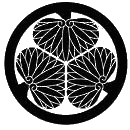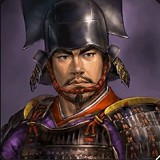

徳川 家康
とくがわ いえやす
Tokugawa Ieyasu
1543 - 1616
 
Appearances: Sengoku Musou (1NPC,2), Sengoku BASARA (1NPC,2NPC)
Tokugawa Ieyasu's origin was the Matsudaira clan. He was
born on January 31st 1543 in Mikawa province (present-day Aichi
prefecture) with the name 松平竹千代 Matsudaira Takechiyo.
The Matsudaira clan was under control by the Imagawa, the influental clan during that time,
based in Suruga, a province located at Mikawa's eastern border.
To secure the alliance, Takechiyo was sent to the Imagawa
fortress as a hostage.
His father, 弘忠 Hirotada, died in 1549. In 1556, he was sent back to
Mikawa to defend his land from the Oda clan which was based in
Owari, west of Mikawa. At this time Takechiyo changed his name
to 松平元康 Matsudaira Motoyasu. In 1560, Imagawa Yoshimoto, the leader
of the Imagawa clan, raised his army to conquer the capital city
Kyoto, and the Matsudaira was ordered to assist him. However
during the march, the Oda clan ambushed the Imagawa army at
Okehazama, and Imagawa Yoshimoto was slain in the midst of the
ambush. With Yoshimoto's death, the Imagawa's influence began to
decline. Soon afterwards, Motoyasu declared his clan independent
from the Imagawa and made a mutual alliance with the Oda. He
became a close comrade of Oda Nobunaga, the leader of the Oda
clan, and assisted the latter's campaigns. In 1566, he
petitioned the court to allow him to change his name to
Tokugawa, a request which was granted. And so from this point he
became known as Tokugawa Ieyasu.
In 1572, the Tokugawa clan was assaulted by the Takeda clan,
which was based northeast of the former's lands. The Takeda
continued to threaten the Tokugawa until the former was able to
beat the latter at the Battle of Mikatagahara on January 6th
1573. The Tokugawa was in verge of defeat, however soon after
the Mikatagahara battle, Takeda Shingen, the able leader of the
aggressor clan, died. So the situation bogged down a little, but
only for a short time, because Shingen's heir 武田勝頼 Takeda Katsuyori
restarted the assault. Ieyasu decided to ask for assistance from
Nobunaga, and on June 29th 1575 at Nagashino, the allied forces
of Oda and Tokugawa were able to crush Takeda's massive cavalry
army with gunfire tactics. The tide of battle turned since then,
and the Takeda was finally annihilated in 1581.
On June 21st 1582, Oda Nobunaga, the most influential ruler
during the time, was betrayed and assassinated in Kyoto -along
with his heir Nobutada- by Akechi Mitsuhide, an Oda vassal.
Ieyasu was staying at Sakai, a city located south of Kyoto, when
the rebellion occurred. It is said that Mitsuhide was after
Ieyasu too, but thanks to one of Tokugawa's most loyal vassals
Hattori Hanzou who was born in the nearby province of Iga, Ieyasu
was able to return to his homeland of Mikawa. Mitsuhide himself
was eventually surprise attacked by Hashiba Hideyoshi, an Oda
general who was supposed to lead a campaign to western regions,
and was killed during retreat.
However, the chaos still didn't end yet. The ambitious Hideyoshi
saw Ieyasu as the next threat, so in 1584, the former challenged
the latter in the Campaign of Komaki. At the end of the year
though, the two clans made a truce and ceased the campaign.
Hideyoshi, who changed his name to Toyotomi Hideyoshi at the
time, increased his influence much faster than the Tokugawa.
Assisted by the latter, the Toyotomi went to unify the entire
Japan. The unification was complete by 1590, but after that,
Hideyoshi went even further as he commanded his army to conquer
Korea and China. The latter campaign ended in an utter failure
though, and as a result, Hideyoshi fell ill and died in 1598.
After Hideyoshi's death, Ieyasu began using his influence he had
built to gain support from other clans. This was opposed by
Ishida Mitsunari, a Toyotomi vassal. The coalition Mitsunari had
gathered went on to confront Ieyasu and his allies at
Sekigahara, on October 21st 1600. The Tokugawa however, already
had much more influence. So in the end, many generals from
Ishida's coalition defected to the Tokugawa, and the battle of
Sekigahara ended with a total victory for Ieyasu's coalition.
Mitsunari was later caught during the retreat and then he was
executed.
In 1603, the Emperor of Japan gave Ieyasu the title of Shogun,
which he held for two years before handing it over to his son
徳川秀忠 Tokugawa Hidetada. However, Ieyasu himself wasn't totally
retired. He supervised the building of the Edo Castle and
ordered a siege to Osaka to finish the Toyotomi clan for good in
1615. There were no more opposition anymore, and to make sure
that there won't be threats coming from outside, Ieyasu launched
an edict that expelled Christians from Japan, and isolated Japan
from foreign trade, excluding the Dutch, Korean and Chinese.
Tokugawa Ieyasu passed away on June 1st 1616, and was succeeded
by Hidetada.
| | |